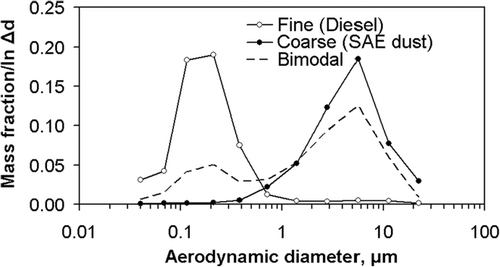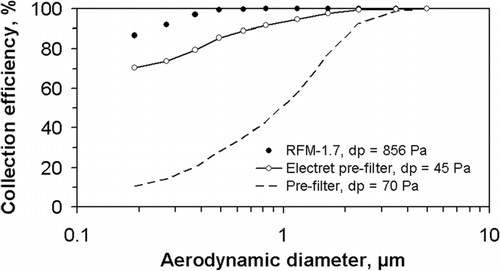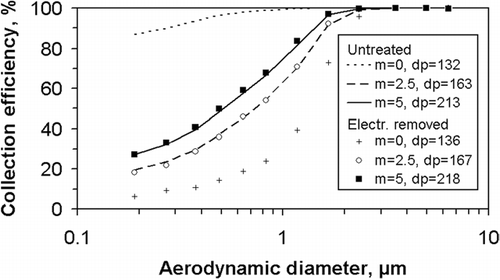Pressure drop evolution during filtration of bimodal aerosol was studied experimentally. A low-pressure drop pre-filter upstream of the actual collection filter was demonstrated to significantly reduce the pressure drop growth rate, when the aerosol is dominated by coarse particles. The pressure drop evolution during depth-filtration, that took place mainly in a pre-filter, could be predicted by adding up the separately measured contributions from the unimodal fine and coarse aerosols. However, the cake filtration (pre-filter was not used) of coarse particles alone resulted in a faster clogging rate as compared to the same amount of coarse particles accompanied with fine particles (mass ratio coarse:fine 3:1). Apparently, fine particles deposited on coarse particles affect their surface properties and thus the porosity of the cake formed.
INTRODUCTION
High-volume (> 100 m3 h−1) air samplers are commonly used for the routine monitoring of radioactive substances in air. A large sample size is favored when filters are analyzed gravimetrically or with methods such as gamma spectroscopy, where the analytical detection limit is better the larger the sample is. With a given sampling pump, the largest possible flow rate depends on the filter flow resistance. A filter resistant to clogging also has an advantage of enabling a long filter-changing interval.
Glass fiber HEPA-filters are commonly used in environmental monitoring due to their excellent particle collection efficiency, but good collection efficiency comes with high initial flow resistance and fast clogging rate during sampling (CitationBrown 1993). A compromise must be made between collection efficiency and clogging rate if a long sampling time is desired. Low-flow resistant polycarbonate, polyvinyl chloride, cellulose, or other filter materials are often used in radioactive aerosol research. They do not contain uranium, unlike glass fiber, and are well suited for preconditioning methods used in radiochemistry because they are ashable in low temperatures and leachable to weak acids.
The outdoor aerosol is bimodal, whereas most previous filter clogging studies have been carried out with monodisperse aerosol. Therefore, we carried out laboratory filtration experiments where the clogging rate with bimodal aerosol was compared with that with fine or coarse particles only. Laboratory studies are aimed at helping to predict and prevent clogging problems, e.g., in a new monitoring site with a known aerosol size distribution. A specific target of this work was to study the reduction in clogging rate by collecting the coarse mode of the bimodal aerosol on a sparse pre-filter.
PREVIOUS STUDIES
Pressure drop Δ p over a filter is proportional to the face velocity v, defined as the volumetric flow rate per filtration area (CitationDavies 1973). Face velocity fixed, the pressure drop grows with the mass of the collected particles as
Often a clear discontinuity point can be observed, when the filtration mode is changed from depth filtration to cake filtration (CitationStenhouse and Trottier 1991). CitationThomas et al. (2001) developed a model to predict the transition. The collected sub-micron particles form dendrites that are considered as new collecting fibers. Cake growth begins when the overall packing density (including the contribution from the collected particles) of the uppermost filter slice reaches a limiting value. The depth filtration continues due to particles penetrating the cake. The coarser the particles are, the more porous the cake is and consequently, the pressure drop growth is slower.
CitationLee et al. (2001) studied the pressure drop evolution of HEPA filters exposed to bimodal aerosol consisting of Al(OH)3 sub-micrometer particles and coarse Arizona dust. The larger the mass ratio of fine to coarse particles was, the faster the pressure drop increased. CitationBabich et al. (2000) found a dependence of the form C 1∼ d p − 1· C c − 1/2, where C c is the slip correction factor. In fact, they built a PM2.5 mass monitor based on detecting pressure drop over the filter. Virtual impactors were used to modify the aerosol size distribution to compensate for the effect of particle size on pressure drop growth rate.
Air humidity also affects the clogging rate. An increase in humidity results in a decreased clogging rate, apparently as then the particles tend to stick to each other forming a cake with an open structure instead of bouncing away and filling interstitial spaces beneath (CitationGupta et al. 1993). An exception is hygroscopic particles collected under humidity higher than the deliquescent point. In that case, a continuous liquid film over the filter surface forms, resulting in fast clogging.
The increasing mass loading on the filter tends to enhance the collection of particles by diffusion, interception and impaction (CitationBrown 1993). Particles in the size range 0.1–1 μ m are the most difficult to collect because they are too small for impaction but too large to collide the fibers by diffusion. The collection efficiency of both charged and uncharged particles can be remarkably enhanced by stationary electric charge on filter fibers. This enhancement takes place with no extra pressure drop involved but with certain aerosols the collection efficiency is reduced during sample collection (CitationLehtimäki 1996). This is because the charge of the fibers is screened by the collected particles (CitationWalsh and Stenhouse 1998). The collection efficiency is increased again due to the enhancement of the other collection mechanisms, as the sample collection is further continued.
EXPERIMENTAL
The filter chosen for the experiments (Petrianov RFM-1.7) is made of polymeric fibers and thus suitable for research projects where radiochemical analysis methods are used. A single layer of RFM-1.7 was compared to a one preceded by an electrically active (electret) organic pre-filter, a non-electret glass fiber pre-filter or another layer of RFM-1.7. Filter packing densities were estimated from the basis weight and thickness, and mean equivalent fiber diameters calculated from Equation Equation3 using measured pressure drop values (). All the filters are sparse, notably compressed under pressure and rather heterogeneous in structure. The initial pressure drop of RFM-1.7, determined from 10 samples, had a standard deviation of 6%. Therefore, the calculated packing densities and effective fiber diameters are to be considered only approximate.
TABLE 1 Filter characteristics
Collection efficiencies of the unloaded filters were determined by measuring the size distribution of diethyl-hexyl sebacate (DEHS, density 0.91 g cm− 3) aerosol with an optical particle size analyser (PMS LAS X) alternately upstream and downstream of the filter. The collection efficiency behaviour of the electrically active filter material was studied in more detail, however using a thicker version (threefold initial pressure drop) of the material. An untreated sample was compared to one exposed to isopropanol to remove the electrical activity. The treated sample was dried for 24 hours before measurements.
Two aerosol particle sources were used in the pressure drop evolution tests (). The coarse particles were SAE fine dust that was dispersed by a RBG-1000 (Palas GmBH) powder dispersion generator. The fine aerosol was exhaust gas from a diesel motorboat engine (YANMAR L40E-D). The test aerosol mass size distributions were measured with a Berner-type low-pressure cascade impactor (CitationBerner and Lürzer 1980). shows that the SAE dust aerosol was unimodal (geometric mean diameter (GMD) = 4.3 μ m and geometric standard deviation (GSD) = 2.5). The diesel exhaust aerosol was also practically unimodal, with 97% of the particle mass in a sub-micron mode (GMD = 0.16 μ m, GSD = 2.0). The bimodal aerosol contained approximately 75 weight% of SAE dust and 25% of diesel fume.
FIG. 1 Experimental set-up (one of the four filter sampling lines is shown). Nebulizer was used in collection efficiency measurements.
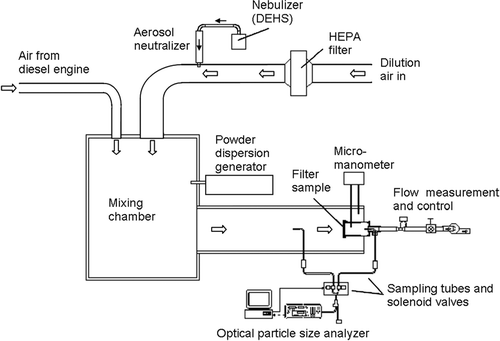
Aerosol (coarse SAE dust, fine diesel fume, or both) and dilution air were directed to a 5 m3 mixing chamber, and then aspirated through four parallel sampling lines, so that the four filter configurations could be exposed simultaneously. The filtration area in each sampling line was 180 cm2, and the face velocity 0.4 m s− 1. Flow rates were measured (venturi tube SFS-ISO 5167-1) and controlled independently for each filter lines. The flow rate accuracy calculated according to the venturi tube standard is 2.3%. Pressure drop was monitored with a micromanometer DPM TT 470 S.
Exposure, or the particle mass in the air aspirated through a filter area unit, was calculated based on mass concentration measured by filter sampling. Millipore (0.8 μ m) filters were weighed before and after each test run by Mettler AE240 analytical balance (reproducibility 0.02 mg, or 1% of the average mass collected on the filter). The air flow rate through the Millipore filters was measured with a gas meter (reproducibility 2%) that has been calibrated against a bubble meter (Gilian Gilibrator). The stability of the loading aerosol concentration was verified by laser photometer (TSI DustTrak).
The loading aerosol mass concentration was 7.2 ± 0.3, 17.8 ± 0.7 and 27 ± 1 mg m− 3 when the filters were loaded with fine, coarse, and bimodal aerosol, respectively. The mass concentrations were not adjusted to be the same, as the differences on this range of concentrations have been found not to affect the pressure drop evolution (CitationThomas et al. 2001).
RESULTS AND DISCUSSION
Collection Efficiency
The unloaded RFM-1.7 captured 87% of the 0.2 μ m particles, and more than 99.9% of the super-micron particles (). As a non-electret material, the collection efficiency is presumably increasing when the filter is exposed to aerosol. Still, the filter mass loading m l during the pressure drop evolution tests using fine or bimodal aerosol is somewhat lower than the exposure m e (mass of particles fed to the filter per filter area).
The unloaded non-electret pre-filter does not contribute significantly to the fine particle collection. Also a substantial fraction of coarse particles penetrates it. On the other hand, the unloaded electret pre-filter collected 70% of the 0.2 μ m particles, yet causing a smaller pressure drop than the other pre-filter. Electrical activity was demonstrated to be the cause of the good collection efficiency (). The studied thick version of the filter collected 88% and 6% of the 0.2 μ m particles before and after the treatment in isopropanol, respectively. After exposure to 2.5 mg cm− 2 of bimodal aerosol, the collection efficiency curves of the treated and untreated samples were similar, indicating that at this stage even the untreated sample had no more gain from the electrical attraction.
Pressure Drop Evolution
Exposure to fine particles resulted in an ever-increasing pressure-drop growth rate (). Clogging became catastrophic after exposure of about 8–10 mg cm− 2. Apparently, depth-filtration was the dominant collection mechanism throughout the exposure. Pre-filters did not significantly lengthen the filter life because they collect only a fraction of sub-micron particles.
The exposure of single and double RFM-1.7 to coarse particles resulted in a depth-filtration phase to about m e = 1 mg cm− 2 followed by a transition to a cake-filtration phase at about m e = 1 to 4 mg cm− 2. After the transition phase, the pressure drop increase was almost linear. The low-pressure-drop pre-filters were working efficiently. They can collect coarse particles with a distinctly smaller additional pressure-drop than RFM-1.7. Even at m e = 10 mg cm− 2, the pressure drop of the pre-filter combinations were mainly due to the almost unloaded RFM-1.7. Visual observation showed that the RFM-1.7 filters located downstream of a pre-filter were heavily loaded after exposure to fine particles, but almost clean when exposed to coarse particles.
Exposure to bimodal aerosol resulted in qualitatively similar behaviour than in the case of coarse particles alone, and the pre-filters were efficient also here. The transition to the cake-collection phase seems to have taken place at about m e = 8 mg cm− 2 (6 mg cm− 2 of them coarse) when there was no pre-filter.
If the coarse and fine particle contributions to pressure drop were additive, then the pressure drop after exposure m e to bimodal aerosol, Δ p b (m e ), could be predicted using the results from the tests with the unimodal aerosols,
compares the measured pressure drop evolution during bimodal aerosol test run to the prediction by Equation (Equation4). It also shows how the predicted increase in Δ p is distributed between the contributions from the fine and coarse aerosol test data. The single and double RFM-1.7 gained pressure drop with a distinctly lower rate than predicted. In fact, a given mass loading of coarse particles alone produced a higher pressure drop than the same amount of coarse particles plus the fine particles,
FIG. 6 Measured pressure drop during exposure to the bimodal aerosol, compared to a prediction based on tests using unimodal fine and coarse aerosols (Equation Equation4, C = 0.75). The uncertainty shown for exposure is 6%.
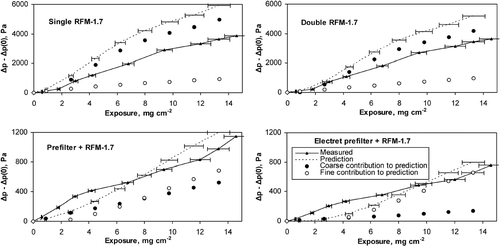
Equation (Equation4) predicts the pressure drop evolution reasonably well if a pre-filter is included. Now, most of the particles are depth-filtrated within the pre-filter. Apparently, the pre-filter matrix is not significantly altered by the 15 mg cm− 2 of the bimodal particles to which it is exposed.
CONCLUSIONS
The pressure drop evolution during collection of bimodal aerosol was studied experimentally. Depth-filtration was the dominant collection mechanism when a low-pressure drop pre-filter preceded the actual collection filter. A reasonable prediction for the pressure drop evolution could be made by monitoring the pressure drop separately for fine and coarse aerosols and adding up the contributions from the two modes.
Cake filtration was dominant when there was no pre-filter. In this case, the pressure drop during exposure to coarse particles alone increased faster than if the same amount of coarse particles was accompanied with fine particles (mass ratio coarse:fine 3:1). Apparently, the coarse particle surface properties were affected by the fine particles deposited on them. The higher surface stickiness may result in enhanced adherence of coarse particles to each other instead of slipping away and penetrating deeper into the cake. Therefore, the cake formed of bimodal particles was more porous and thus less flow-resistant than that formed of the coarse particles alone.
A low-pressure drop pre-filter upstream of the actual filter was demonstrated to significantly lengthen the filter life-time when the aerosol was dominated by coarse particles. Pre-filters were not efficient for the fine aerosol because most of the fine particles penetrated them. This was also the case for the electret-type pre-filter because good initial sub-micron particle collection efficiency was lost during the early stages of sampling.
The findings indicate, that the aerosol size distribution is an important part of filter type selection criteria when an extended filter-changing interval is necessary. A sparse pre-filter preceding the actual filter may be feasible when bimodal aerosol is collected, even if the tests with unimodal fine aerosol would not show any significant reduction in filter clogging rate.
NOMENCLATURE
| C | = |
coarse particle mass fraction of the bimodal aerosol |
| [dbar] f | = |
mean equivalent fiber diameter, m |
| d p | = |
particle diameter, m |
| h | = |
filter thickness, m |
| m e | = |
exposure, or mass of particles fed to the filter per filter area, kg m− 2 |
| m l | = |
mass loading, or collected particle mass per filter area unit, kg m− 2 |
| v | = |
face velocity, m s− 1 |
| = |
Greek Symbols | |
| α | = |
filter packing density, dimensionless |
| Δ p | = |
pressure drop, Pa |
| ρ p | = |
particle density, kg m− 3 |
| μ | = |
dynamic viscosity of air, Pa · s |
REFERENCES
- Babich , P. , Wang , P.-Y. , Allen , G. , Sioutas , C. and Koutrakis , P. 2000 . Development and Evaluation of a Continuous Ambient PM2.5 Mass Monitor . Aerosol Sci. Technol. , 32 : 309 – 324 . [CSA]
- Bergman , W. , Taylor , R. D. , Miller , H. H. , Biermann , A. H. , Hebard , H. D. , Da Roza , R. A. and Lum , B. Y. 1978 . Enhanced filtration program at LLNL . 15th DOE Nuclear Air Cleaning Conf. 1978 , Boston.
- Berner , A. and Lürzer , C. 1980 . Mass Size Distributions of Traffic Aerosols at Vienna . J. Phys. Chem. , 84 : 2079 – 2083 . [CROSSREF] [CSA]
- Brown , R. C. 1993 . Air Filtration: An Integrated Approach to the Theory and Applications of Fibrous Filters , Oxford : Pergamon Press .
- Davies , C. N. 1973 . ir Filtration , New York : Academic Press .
- Gupta , A. , Novick , V. J. , Biswas , P. and Monson , P. R. 1993 . Effect of Humidity and Particle Hygroscopicity on the Mass Loading Capacity of High Efficiency Particulate Air (HEPA) Filters . Aerosol Sci. Technol. , 19 : 94 – 107 . [CSA]
- Japuntich , D. A. , Stenhouse , J. I. T. and Liu , B. Y. H. 1997 . Effective Pore Diameter and Monodisperse Particle Clogging of Fibrous Filters . J. Aerosol Sci , 28 : 147 – 158 . [CROSSREF] [CSA]
- Lee , J.-K. , Kim , S.-C. and Liu , B. Y. H. 2001 . Effect of Bi-Modal Aerosol Mass Loading on the Pressure Drop for Gas Cleaning Industrial Filters . Aerosol Sci. Technol , 35 : 805 – 814 . [CROSSREF] [CSA]
- Lehtimäki , M. 1996 . “ Development of test methods for electret filters ” . In Nordtest Technical Report 320 Espoo, , Finland
- Stenhouse , J. I. T. and Trottier , R. A. 1991 . The loading of fibrous filters with submicron particles . J. Aerosol Sci. , 22 : S777 – S780 . [CROSSREF] [CSA]
- Thomas , D. , Contal , P. , Renaudin , V. , Penicot , P. , Leclerc , D. and Vendel , J. 1999 . Modelling Pressure Drop in HEPA Filters during Dynamic Filtration . J. Aerosol Sci , 30 : 235 – 246 . [CROSSREF] [CSA]
- Thomas , D. , Penicot , P. , Contal , P. , Leclerc , D. and Vendel , J. 2001 . Clogging of Fibrous Filters by Solid aerosol Particles. Experimental and Modelling Study . Chem. Engineer. Sci , 56 : 3549 – 3561 . [CROSSREF] [CSA]
- Walsh , D. C. and Stenhouse , J. I. T. 1998 . Parameters Affecting the Loading Behavior and Degradation of Electrically Active Filter Materials . Aerosol Sci. Technol , 29 : 419 – 432 . [CROSSREF] [CSA]
